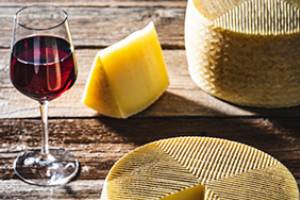|
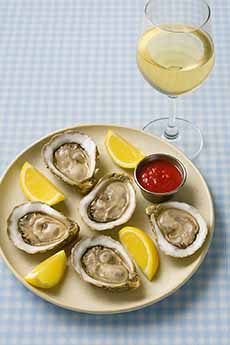
[1] Cherrystone clams on the half shell with a glass of Chardonnay (photo by Chat GPT 2025-03-31).
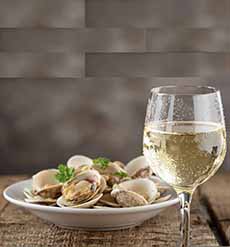
[2] Topneck clams with a glass of sparkling wine (photos #2 and #3 by FLUX 1.1 2025-03-31).
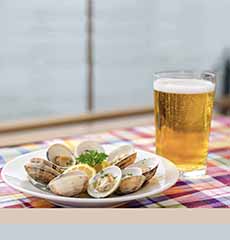
[3] Littleneck clams with a beer.
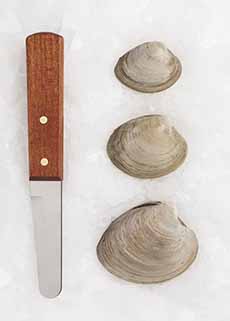
[4] A comparison of some quahog sizes, from the top: littleneck, topneck, and cherrystone. Here’s more about these and other sizes of hard-shell clams (photo © Atlantic Aqua Farms).
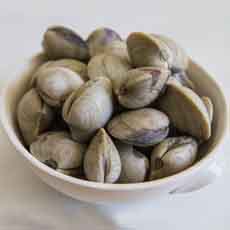
[5] A bowl of littleneck clams (photos #5 and #8 © Good Eggs).
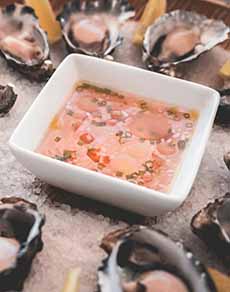
[6] Mignonette sauce. The recipe is at the right (photo © Lachlan Ross | Pexels).
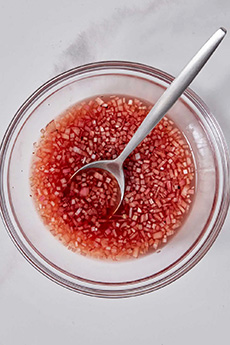
[7] Here’s another Mignonette sauce recipe, with advice on swapping out the vinegar and the allium (photo © New York Times | Joel Goldberg photographer | Barrett Washburn food stylist).
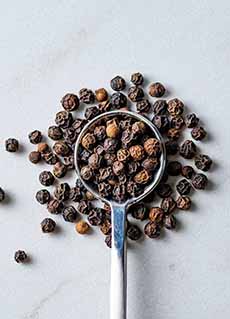
[8] Cracked pepper is an essential ingredient in Mignonette Sauce. If you don’t have a peppermill that can grind them coarsley, see other techniques in the footnote† below (photo © Savory Spice Shop).
|
|
We know what we’re having after work today: clams on the half. It’s National Clams On The Half Shell Day, celebrating a plate of raw clams with a squeeze of lemon, mignonette sauce, or cocktail sauce.
We’ve invited neighbors, tasking one with the shucking. The next question coming up: What to drink?
The recommendations that follow also work with oysters on the half shell.
> Below: What types of clams are served on the half shell?
> The different types of clams.
> The history of clams.
> A recipe for Mignonette Sauce (photo #6) is below.
> So are the year’s 56 fish and seafood holidays.
1. CLAMS ON THE HALF SHELL WITH WINE
Clams on the half shell pair best with crisp, dry, minerally wines, which complement their brininess.
We’re using the opportunity to have a wine pairing with bottles of:
Albariño, a Spanish white with high acidity and stone fruit notes that match the delicate sweetness of clams.
Chablis, a mineral-forward, unoaked Chardonnay from Burgundy that enhances the clams’ natural flavors.
Champagne or other sparkling wine—the effervescence and acidity pair beautifully with the salinity of the clams (photo #2).
Muscadet, a light, dry white from the Loire Valley, with bright acidity and salinity.
Sancerre, a crisp Sauvignon Blanc from the Loire Valley with citrus and herbal notes.
If you want to keep your dollars in the U.S., try:
Albariño from Oregon’s Columbia Valley.
Chenin Blanc from Washington.
Pinot Gris from Oregon.
Riesling from Oregon’s Willamette Valley or New York’s Finger Lakes.
Sauvignon Blanc from Napa or Sonoma.
Sparkling wines from California, New York Finger Lakes, Oregon Willamette Valley, or Washington State.
Unoaked Chardonnay from California’s Santa Barbara or Sonoma Coast areas or from Long Island (photo #1).
2. CLAMS ON THE HALF SHELL WITH BEER
If your crowd prefers beer, this is not the time to bring out the a IPA. Instead, choose:
Pilsner, crisp and clean, won’t overpower the delicate taste of the clams (photo #3).
Saison, a farmhouse ale with a hint of spice and citrus that complements the shellfish.
Witbier, the Belgian wheat beer with light citrus and coriander notes that also play well with the clams.
> Here’s more about these types of beer.
3. CLAMS ON THE HALF SHELL WITH COCKTAILS
For the cocktail crowd, serve
Dry Gin Martini, but not a Dirty Martini—the olive juice can overwhelm the fresh shellfish.
Gin & Tonic, refreshing and herbal, a good match for raw seafood.
Straight Spirits: aquavit or vodka (including cucumber-infused vodka), chilled or on the rocks—clean and crisp flavors that don’t compete with the clams.
4. CLAMS ON THE HALF SHELL WITH NON-ALCOHOLIC DRINKS
Sparkling water with a big squeeze of fresh lemon or lime.
Infused water with cucumbers and/or fresh herbs. Recipes:
> Cucumber Water
> Lemon-Cucumber Water
> Herbal Water
WHAT TYPE OF CLAMS ARE SERVED ON THE HALF SHELL?
Littleneck clams, a small variety of quahog clams (hard-shelled clams, Mercenaria mercenaria), are by far the most common clam served on the half shell in the U.S. They’re small, tender, and sweet with a briny flavor.
Cherrystone clams are also quahogs, slightly larger than littlenecks.
Topneck clams are a size in-between littlenecks and cherrystones.
Manila clams, more available on the West Coast, can be served raw although are more commonly cooked in soups and noodle dishes.
RECIPE: MIGNONETTE SAUCE FOR CLAMS & OYSTERS
Ideally make this the day before; or allow two hours for the flavors to blend and the shallots to soften. It will keep in the fridge for months.
(Of course, if you need to use it ASAP, go right ahead.)
If you don’t have red wine vinegar, use another fine vinegar: Champagne vinegar, white wine vinegar, even sherry vinegar. You can even use white balsamic vinegar, but steer clear of regular balsamic.
While we usually don’t use the “optional” ingredients which can mask the delicate bivalve flavors, we include them
Ingredients
½ cup red wine vinegar
2 tablespoons minced shallots
½ teaspoon freshly cracked† (or coarsely ground) black pepper
Pinch of salt
Optional: pinch of sugar
Optional: minced jalapeño or other chili, squeezer of lemon or lime, fine dice of apple (with skin) or cucumber (peeled)
Variation
As an alternative to mignonette, make what we call “Asian chimichurri sauce” with white wine or rice vinegar, minced shallots, minced garlic, and grated ginger, lightly seasoned with salt and pepper.
Preparation
1. COMBINE all ingredients in a small bowl and whisk to combine.
2. SET aside at room temperature for 2 hours for the flavors to meld. Then, use or refrigerate.
The History Of Mignonette Sauce
Historically, vinegar-based sauces have been used for centuries to complement seafood. Mignonette sauce originated in France as a condiment for oysters on the half shell, and gained popularity in the 19th century. The original was a simple blend of shallots, vinegar, and cracked black pepper. Its sharp, tangy, and slightly spicy flavors was designed compliment the brininess of the oysters.
Today, variations include additions like citrus juice, herbs, or even a touch of sugar to balance the acidity. Cooks have enhanced the sauce with diced apples, cucumbers, and other fruits.
The word mignonette comes from the French word mignon, meaning small or delicate.
In old French cooking, poivre mignonette referred to the cracked or coarsely ground black pepper, which is an essential ingredient in the sauce.
________________
†How to crack peppercorns without a coarse grinding setting on your peppermill: Grind them with a mortar and pestle. Or put the peppercorns in a sealed plastic bag and use a rolling pin, heavy pan, meat mallet, or knife blade to crack them. You can also pulse the peppercorns briefly in a coffee grinder or spice grinder.
|








